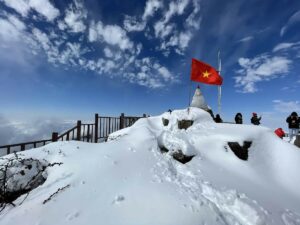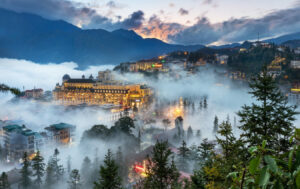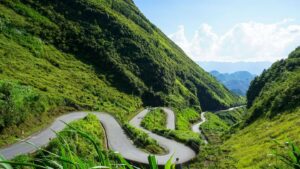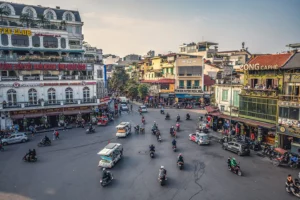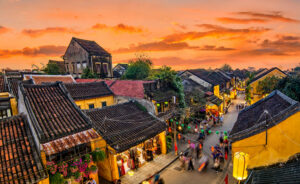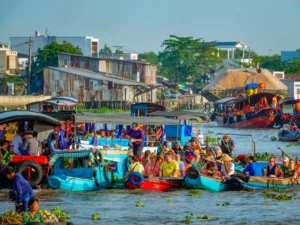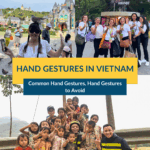
Ultimate Guide to Visit Vietnam in Winter: 10 Best Destinations and Activities
When most people think of Vietnam, they imagine golden beaches, lush rice fields, and tropical sunshine. But did you know Vietnam in winter offers an entirely different travel experience? From misty mountains in the north to warm southern islands, the country transforms into a land of contrasts that surprises and delights travelers.
If you are planning a journey to Vietnam in winter, this guide by Prime Travel will take you through everything you need to know to prepare for your trip: Vietnam’s weather in winter, top winter destinations, and what to pack for a smooth trip.
Is it good to visit Vietnam in winter?
Overview of winter in Vietnam
Vietnam’s climate is shaped by its long, narrow geography stretching over 1,600 kilometers from north to south. The country lies in a tropical monsoon zone, which means it experiences both wet and dry seasons, with significant variations between regions. While the south enjoys a tropical climate year-round, the north has more distinct seasons, including a cooler winter that contrasts with the hot, humid summer.
Winter in Vietnam typically lasts from November to February, though its effects are felt most strongly in the northern provinces. In the north, including Hanoi and Sapa, winter temperatures range from 10–25°C (50–77°F).
In the mountains, it can dip close to freezing, and in rare cases, snow blankets the high peaks like Fansipan or Mau Son. Misty mornings, chilly winds, and a crisp atmosphere make northern Vietnam in winter especially charming.
In central Vietnam, which includes Hue, Da Nang, and Hoi An, the season is milder. Temperatures hover between 18–24°C (64–75°F), creating pleasant conditions for sightseeing. However, this region is prone to rainfall and occasional storms during the transition months, so visitors should expect some wet days.
In southern Vietnam, including Ho Chi Minh City, the Mekong Delta, and Phu Quoc Island, winter time means the dry season. Temperatures stay warm, averaging 25–30°C (77–86°F), with little rain. It’s the best time to enjoy beaches, outdoor adventures, and cultural exploration without the heavy humidity of summer.
This seasonal variety across Vietnam makes it one of the best times to travel, as visitors can experience completely different climates with distinct landscapes within a single trip.
Read more>>>Vietnam Weather by Month: 12-Month Guide for Travelers’ Best Trip
Should you travel to Vietnam in winter?
Yes. Winter is actually one of the best times to visit Vietnam in winter for travelers who prefer cooler, more comfortable weather. The season brings milder temperatures, making it easier to enjoy outdoor activities like walking tours, sightseeing, or exploring markets. With fewer tourists compared to peak months, you’ll also find less crowded attractions and better travel deals. For those seeking a more relaxed and authentic experience, visiting Vietnam in winter is definitely a good choice.
Why visit Vietnam in winter?
There are many reasons why travelers choose to visit Vietnam in winter. The most obvious one is the weather. Compared to the hot and humid summer, winter in Vietnam brings cooler and more pleasant temperatures, especially in the north. This makes walking tours, outdoor sightseeing, or even longer hikes much more enjoyable without the discomfort of extreme heat.
It’s also a great time for exploring Vietnam’s vibrant cities, where you can stroll through old quarters, visit cultural landmarks, and take part in street food tours without feeling overwhelmed by the climate.
Another reason is that winter can offer diverse travel experiences. For adventure seekers, the northern highlands are especially appealing in winter. Meanwhile, cultural destinations like Hanoi or Hue feel more relaxed, as you can stroll comfortably without the sweltering heat. You can also enjoy a tropical escape in southern Vietnam during winter.
Last but not least, another benefit of traveling to Vietnam in winter is the reduced crowds. While summer and major holidays attract many domestic and international tourists, the winter season is often less busy.
This means shorter lines at attractions, a calmer atmosphere, and more authentic encounters with local culture. On top of that, prices for hotels, tours, and transportation are often more affordable compared to peak seasons.
Whether you’re dreaming of misty mountains in the North or sunny beaches in the South, we’ve got the perfect itinerary for you. Check out our best-selling tours — from a 5-day Northern Vietnam discovery, a 7-day cultural journey, to an 18-day South-to-North Vietnam adventure.
Read more>>>Travel to Vietnam from Philippines: Best Tours and Travel Information 2025
Top 10 Vietnam destinations in winter
From North to South Vietnam, you can explore many destinations that suit your travel style. Here are some must-visit destinations for your upcoming trip:
Sapa
Sapa is one of the most magical destinations to experience during Vietnam’s winter. The cooler weather creates a dreamy atmosphere with misty valleys and rolling mountains. Winter highlights here include trekking through terraced rice fields, visiting local villages, and enjoying breathtaking mountain views.
Aside from the scenery, winter in Sapa is also a cultural experience. The ethnic minority groups, such as the Hmong and Dao people, welcome travelers with warm hospitality and traditional markets. Visiting Sapa in winter is perfect for those who love adventure, photography, and authentic cultural encounters.
Ha Giang Loop
The Ha Giang Loop is one of the most thrilling journeys to take during Vietnam’s winter. With winding mountain passes, dramatic limestone peaks, and vast valleys, the scenery becomes even more striking under the crisp, cool air.
Winter is one of the best times to ride through the passes in the Ha Giang Loop. Unlike the scorching summers, winter offers pleasant daytime temperatures, making it easier to explore at a steady pace.
Ta Xua
Ta Xua, located in Son La Province, is one of Vietnam’s best mountain destinations for cloud hunters, offering a sense of relaxation and exploration. During winter, from November to March, the weather creates the perfect conditions for Ta Xua’s famous “sea of clouds.”
Early mornings are especially magical, as layers of white mist drift over the mountains, giving you a surreal, otherworldly view that feels straight out of a fantasy movie.
Besides cloud hunting, Ta Xua offers a peaceful retreat for those seeking off-the-beaten-path experiences. The cool, crisp air makes trekking and motorbiking more enjoyable, with scenic routes leading to Dinosaur Backbone Ridge – a must-visit and breathtaking viewpoint.
Visiting Ta Xua, you can cozy up by a fireplace in a traditional place, enjoy local cuisine, and take in the breathtaking view of the mountains.
Hanoi
Winter in Hanoi, lasting from November to February, brings cool, dry weather that perfectly complements the city’s charming atmosphere. Temperatures range from 15°C to 20°C, making it pleasant to stroll through tree-lined boulevards, explore the Old Quarter, or relax at a sidewalk café with a hot cup of egg coffee.
The misty mornings and crisp evenings give Hanoi a cozy, romantic vibe, ideal for travelers who enjoy a laid-back city experience.
The cooler weather is perfect for walking tours, street food adventures, and exploring vibrant markets. Don’t miss trying a steaming bowl of pho. With its blend of history, culture, and seasonal charm, Hanoi in winter offers a truly authentic and heartwarming Vietnam experience.
Read more>>>Ultimate Guide To Hanoi Train Street Time Table, Location In 2025
Ha Long Bay
Ha Long Bay in winter offers a completely different charm from its summer scenes. From November to February, temperatures range between 15°C and 22°C, creating a cool and misty atmosphere that adds a mysterious beauty to the limestone karsts rising from the emerald waters.
While it may not be the best time for swimming, this season is ideal for sightseeing, cruising, and photography, as the fog and calm sea give the bay a dreamlike quality.
Winter in Ha Long Bay is also quieter, with fewer tourists and smoother sailing conditions. You can enjoy a relaxing cruise, visit floating villages, or explore hidden caves like Sung Sot and Thien Cung without the usual crowds.
The cooler weather makes outdoor activities such as kayaking or hiking on Titop Island more comfortable. For travelers seeking tranquility and stunning scenery, Ha Long Bay in winter promises a peaceful yet unforgettable experience.
Hoi An
Hoi An in winter is a delightful mix of mild weather, cultural charm, and relaxed seaside vibes. Cooler weather in winter makes it pleasant for strolling through the lantern-lit Ancient Town or cycling around the countryside.
You can explore the Japanese Covered Bridge, take a cooking class, or visit local markets without the summer crowds. Hoi An’s beaches, like An Bang, remain calm and scenic, perfect for taking photos. Visiting Hoi An in winter lets you experience its authentic charm and slower pace, ideal for a cultural escape combined with gentle relaxation.
Hue
Winter is one of the most atmospheric times to visit Hue, the former imperial capital of Vietnam. From November to February, the city experiences cool weather ranging between 18°C and 23°C, often accompanied by light rain and mist.
This creates a nostalgic, almost poetic feel that perfectly matches the city’s historical charm. Strolling through the Imperial Citadel or visiting ancient tombs like those of Emperor Tu Duc or Khai Dinh feels even more peaceful under the winter drizzle.
Hue in winter offers a different kind of beauty: quiet, reflective, and deeply cultural. You can spend your days exploring pagodas, enjoying traditional Hue cuisine such as Bun Bo Hue, or taking a boat ride along the Perfume River surrounded by misty landscapes. The cooler air makes sightseeing comfortable, and with fewer tourists around, you’ll have plenty of space to take in Hue’s tranquil and timeless atmosphere.
Da Lat
Known as one of the most romantic and magical cities in Vietnam, Da Lat is one of the best destinations to visit in winter. From November to February, the weather here is quite cold and refreshing, averaging between 10°C and 20°C. The air is crisp, the skies are clear, and the city bursts with blooming flowers, especially during the famous Da Lat Flower Festival held every two years.
Winter in Da Lat is ideal for outdoor adventures and romantic getaways. You can stroll around Xuan Huong Lake, explore the vibrant Da Lat Market, or visit flower gardens and strawberry farms.
For nature lovers, waterfalls like Datanla or Pongour are particularly stunning after the rainy season. If you’re in for an adventurous experience, go for a hike at LangBiang Mountain.
With its peaceful vibe, European-style villas, charming cafés, and stunning mountains, Da Lat offers the perfect mix of relaxation and exploration during Vietnam’s winter season.
Phu Quoc Island
For those who seek a warm, tropical escape, Phu Quoc Island is one of the best destinations to visit in Vietnam in winter. From November to March, Phu Quoc Island is in its dry season, offering warm temperatures, calm seas, and clear skies. This weather condition is perfect for swimming, snorkeling, and sunbathing.
Phu Quoc offers more than just pristine beaches like Sao Beach and Long Beach. Travelers can explore the island’s lush forests in Phu Quoc National Park, visit the local night market, or take a cable car ride to Hon Thom Island.
The winter months are also ideal for diving trips, as visibility underwater is excellent. With its tropical weather and laid-back atmosphere, Phu Quoc is the ultimate winter escape in Vietnam for those seeking warmth and relaxation.
Mekong Delta
The Mekong Delta is another wonderful destination to visit in winter, especially for those who enjoy cultural experiences and scenic river landscapes. During the winter months, the weather is pleasantly cool and dry, making it an excellent time for boat tours through floating markets, lush fruit orchards, and tranquil villages.
Traveling through the delta, you can witness the local floating market in the early morning which is bustling with people trading goods and exchanging conversations. Visit the Tra Su Cajuput Forest, where you can enjoy bird-watching and serene boat rides through lush greenery.
Read more>>>Travel To Vietnam with Kids: ULTIMATE Guide To Vietnam for Family Vacation
What to pack to travel to Vietnam in winter
Packing for Vietnam in winter depends on your itinerary, as the weather can vary across the country. Generally, the north experiences colder weather, while the south remains pleasantly warm. To stay comfortable wherever you go, packing versatile clothing is key.
- Light layers such as T-shirts, long-sleeve tops, and thin sweaters are perfect for most regions. If you plan to visit northern destinations like Hanoi, Sapa, or Ha Giang, bring a warm jacket or fleece for the colder mornings and evenings.
- A light waterproof jacket or poncho can be handy for sudden rain showers, especially if you’re traveling between regions.
- Comfortable walking shoes are a must for exploring cities or trekking in the mountains, while sandals or slip-ons work well for beach destinations.
- Accessories like a hat, sunglasses, and sunscreen will help protect you from the sun during outdoor activities.
- If you plan to visit temples or pagodas, visitors should dress modestly when entering temples and cover their shoulders and knees.
With these smart packing tips, you’ll be well-prepared to visit Vietnam in winter.
Highly recommend Vietnam tours
- Highlights North of Vietnam Package (5 days 4 nights)
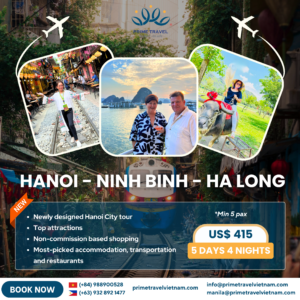
- 14-Day Cultural and Culinary Journey Through Vietnam

- 14-Day Vietnam Soft Adventure
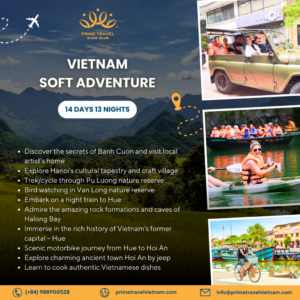
- 10-Day Mekong Delta Cultural Experience from Vietnam to Cambodia

>>Explore more>>
Hidden Gems of Vietnam – Top 10 Off the Beaten Path and Local Experiences
Ultimate Vietnam Summer Travel Guide 2025: Weather, Best Places & Insider Tips
Vietnam Tours From Australia: Best Tours And Holiday Packages 2025


